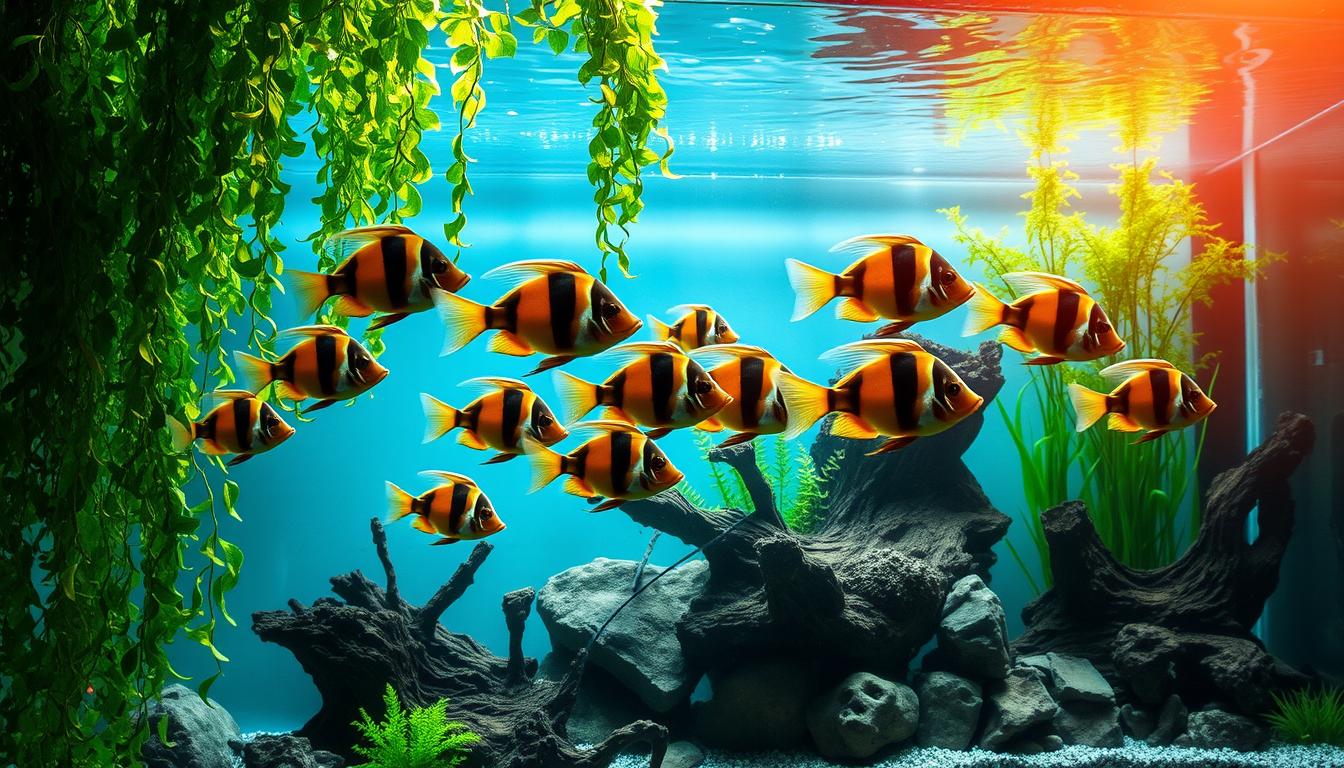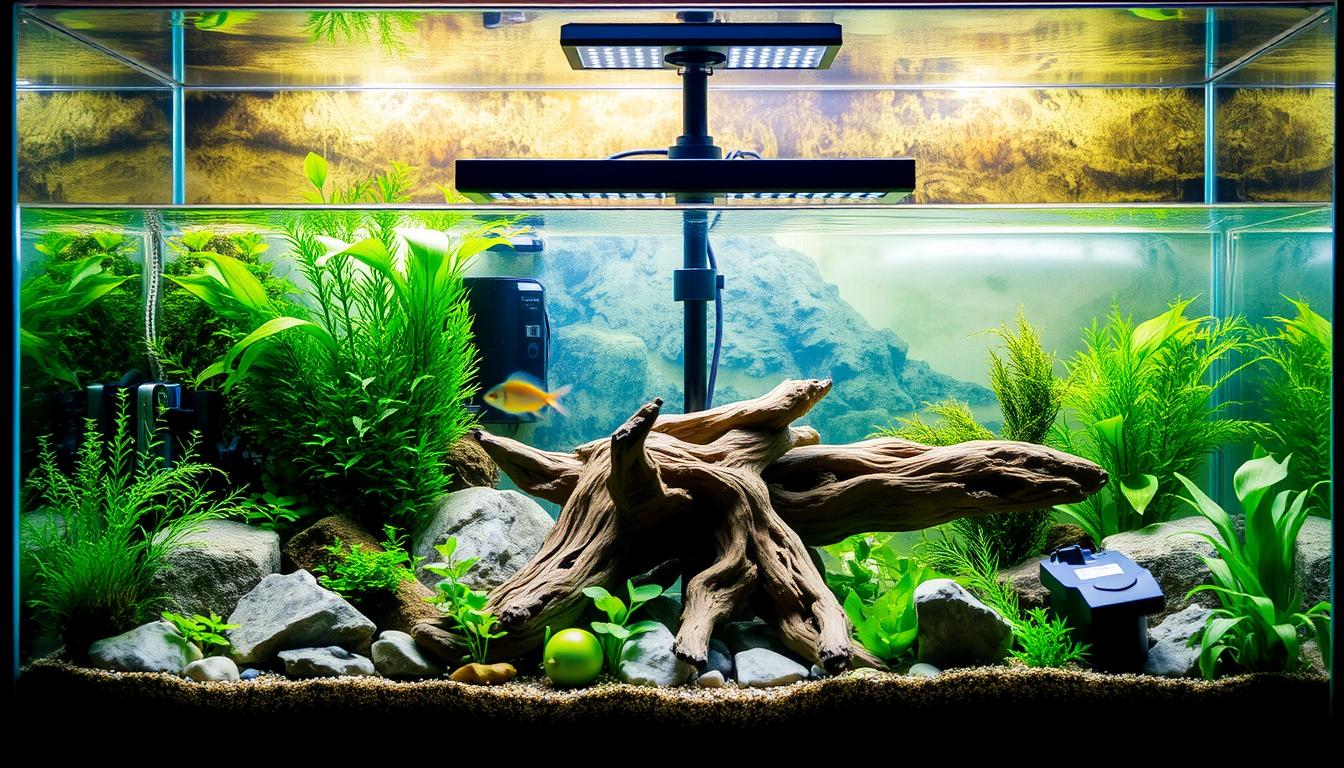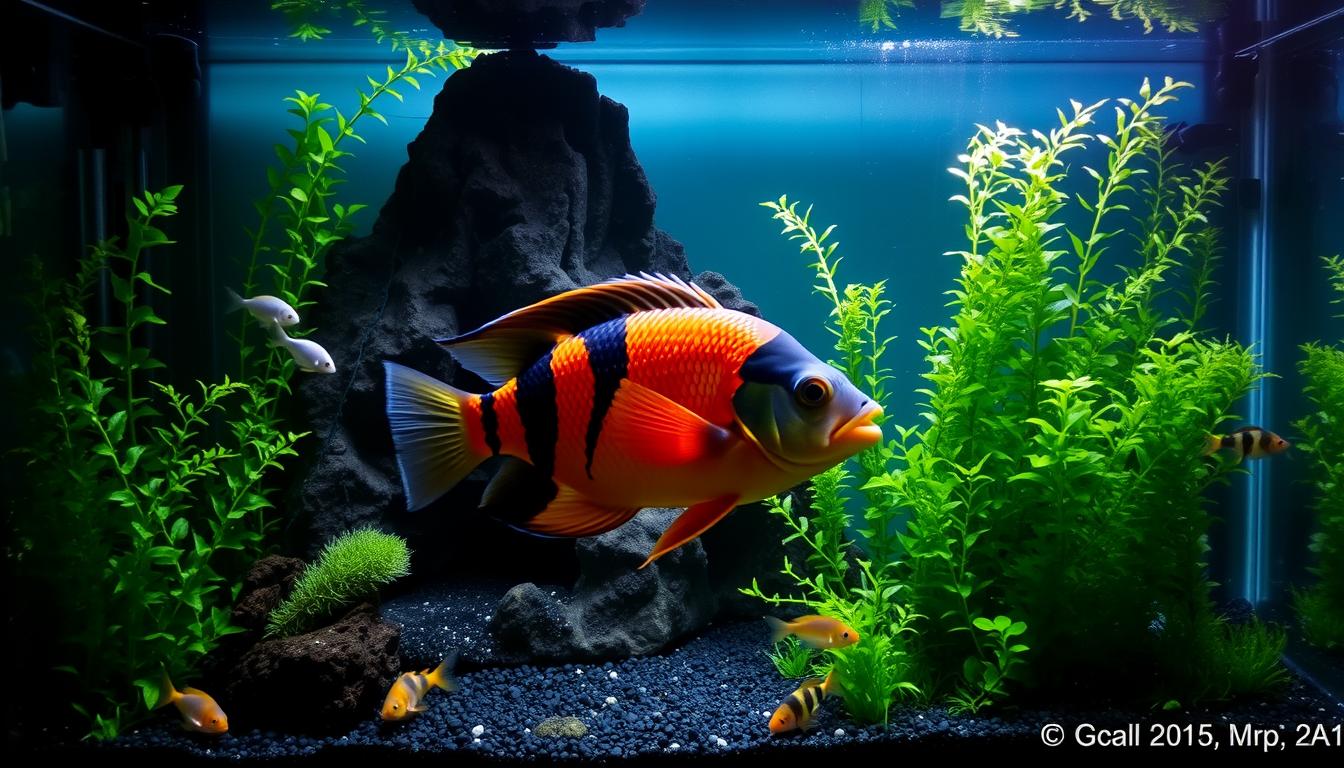How Long Do Oscar Fish Live in Captivity vs the Wild?
This post may contain affiliate links.
What if your aquarium could house a pet that outlives most dogs? These vibrant South American cichlids challenge assumptions about aquatic life expectancy, thriving for over a decade with proper care. Their journey from juvenile explorers to seasoned tank rulers reveals surprising truths about environmental impacts on longevity.
Captive specimens often reach 10-20 years – nearly double the survival rate of wild counterparts facing predators and food shortages. The first year proves critical: rapid growth establishes foundations for lifelong health. While nature tests resilience, aquarists control variables like water quality and nutrition to maximize vitality.
This guide explores why tank-raised oscars frequently become generational pets, contrasting their stability against the unpredictable Amazon Basin. You’ll discover how habitat design, dietary choices, and monitoring routines create ideal conditions for these intelligent swimmers to flourish.
Key Takeaways
- Environmentally controlled tanks typically extend life expectancy compared to natural habitats
- First-year growth patterns strongly influence long-term health outcomes
- Predator-free environments and consistent meals boost survival rates
- Water parameter management directly impacts vitality and disease resistance
- Documented cases show exceptional care leading to near 20-year longevity
Introduction to Oscar Fish: A Vibrant Aquatic Species
Imagine a pet that splashes with personality and flashes jewel-toned scales like living artwork. The Astronotus ocellatus stands out among freshwater aquarium fish for its remarkable combination of brains and beauty. These interactive swimmers transform glass tanks into dynamic ecosystems through their curious nature and striking color patterns.
Unique Personality and Appearance
Often called “water puppies”, these intelligent creatures recognize their caretakers and swim eagerly to greet them. With training, they’ll gently take food from fingers, showcasing cognitive abilities rare in aquatic pets. The popular tiger oscar variety stuns observers with its fiery orange streaks against midnight-black canvas, while albino and lemon morphs offer softer hues.
Origins and Natural Habitat in South America
Native to warm river systems across South America, wild populations thrive in shaded waterways dotted with submerged logs and rocky hideouts. This environment shaped their love for sheltered spaces and stable water conditions. Tank setups mimicking these features help maintain the species’ natural behaviors and stress-free existence.
Their emotional depth surprises many owners – rearranged decor might trigger visible sulking. This sensitivity underscores why proper habitat replication matters for these expressive fish species. From Amazonian roots to modern aquariums, Astronotus ocellatus continues captivating enthusiasts worldwide.
Oscar Fish Lifespan in the Wild
Rivers pulse with life where these robust swimmers carve their existence. Survival becomes a daily chess match beneath South America’s murky waters, where rapid growth and environmental savvy determine success.
Natural Growth Patterns and Size
Juveniles sprint toward adulthood, packing on inches like Olympic athletes. Most reach 10-12 inches within their first year – a survival strategy against larger predators. This explosive development burns energy reserves, demanding constant foraging in nutrient-rich waters.
Full maturity brings impressive dimensions. Prime specimens stretch beyond 14 inches in optimal habitats, though crowded or food-scarce areas stunt development. Size directly impacts mating opportunities and territory control, creating fierce competition among wild populations.
Environmental Factors Impacting Longevity
Nature’s mood swings test resilience. Dry seasons shrink waterways, concentrating predators and triggering food wars. Floods dilute hunting grounds, forcing extended migrations. Water chemistry shifts daily – dissolved oxygen levels can plummet without warning.
Three key threats loom large:
- Piranha ambushes near submerged logs
- Parasite outbreaks during temperature spikes
- Algae blooms choking vital oxygen supplies
Adaptation becomes their superpower. Those mastering seasonal rhythms often outlast rivals, though few celebrate double-digit birthdays. River currents carry constant reminders: survival here earns no guarantees, only temporary reprieves.
Oscar Fish lifespan: Maximizing Life in Captivity
Transforming glass walls into thriving ecosystems requires strategic planning. Aquatic pets flourish when their home mirrors natural rhythms while eliminating survival challenges. Let’s explore how controlled habitats unlock extended vitality for these intelligent swimmers.

Safety Nets Replace Survival Struggles
Wild specimens navigate ever-changing currents and hungry predators. Captive environments flip this script entirely. Stable water chemistry prevents the stress-induced health issues common in natural waterways. Consistent temperatures and filtration systems create perpetual “perfect days” for growth.
Nutrition plays equally vital roles. Unlike their wild cousins scavenging for meals, tank residents enjoy:
- Balanced protein-rich diets
- Scheduled feeding times
- Vitamin-enhanced supplements
Preventative Measures for Lasting Health
Proactive monitoring separates adequate care from exceptional stewardship. Weekly water tests catch pH shifts before they escalate. Spacious tanks (75+ gallons) reduce territorial stress, while robust filtration keeps ammonia levels near zero.
Veterinarians specializing in aquatic life recommend:
“Think of their habitat as a living machine – every component must work in harmony.”
Documented cases show specimens reaching 15-20 years through meticulous attention to these details. From water changes to dietary variety, each choice builds toward remarkable longevity. Your dedication today writes their tomorrows.
Aquarium Setup and Environment for Optimal Health
Creating a thriving underwater home starts with smart spatial planning. Aquatic habitats demand careful balance between open exploration zones and secure retreats. Let’s explore how to craft spaces where vibrant personalities can flourish.

Space Requirements and System Essentials
Water volume forms the foundation of healthy habitats. While 75 gallons meets minimum needs for single residents, experts advocate for 100+ gallon tanks. Larger volumes dilute waste and reduce maintenance frequency.
| Tank Size | Dimensions | Recommended Use |
|---|---|---|
| 75 gallons | 48″L x 18″W | Single juvenile |
| 100 gallons | 72″L x 18″W | Single adult |
| 125 gallons | 72″L x 24″W | Multiple adults |
Filtration systems must handle three times the tank’s volume hourly. Canister filters excel at managing heavy bioloads while maintaining gentle flow. Pair with:
- Pre-filter sponges
- Surface skimmers
- Weekly water tests
Decor choices impact both safety and behavior. Smooth river rocks and driftwood create natural boundaries without injury risks. Leave 40% open swimming areas to accommodate energetic bursts and turns.
Diet and Nutrition: Fueling a Long Life
Proper nutrition acts as the cornerstone for vibrant aquatic companions. These intelligent swimmers thrive when meals mirror their natural foraging behaviors while meeting modern dietary science standards. Let’s explore how strategic feeding practices unlock peak health and vitality.

Natural Feeding Habits and Preferred Foods
Wild specimens hunt diverse prey, from crunchy insects to plant matter. Replicating this variety in captivity prevents nutritional gaps. High-protein cichlid pellets form the dietary backbone, supplemented with live or frozen treats like bloodworms and krill.
Supplementing Diets with Brine Shrimp and Pellets
Brine shrimp offer more than protein – they spark natural hunting instincts. Pair these with vitamin-enriched pellets for balanced meals. A structured feeding plan might look like this:
| Food Type | Benefits | Frequency |
|---|---|---|
| Cichlid pellets | Complete vitamins/minerals | Daily (70% intake) |
| Brine shrimp | Protein boost | 3x weekly |
| Earthworms | Mental stimulation | 2x weekly |
Tips to Avoid Overfeeding and Promote Health
Use the three-minute rule: offer only what they can consume quickly. Split meals into 2-3 small portions daily. Avoid feeder goldfish – they often carry parasites and lack nutritional value. Remember, begging behavior doesn’t equal hunger!
Rotate food types weekly to prevent boredom and deficiencies. This approach mimics wild feeding patterns while maintaining water quality. Your reward? Active, colorful companions showcasing nature’s brilliance in every glide.
Tank Mates and Social Behavior Considerations
Building a thriving aquatic community starts with smart pairing strategies. These charismatic cichlids demand companions that match their bold personalities while respecting their space needs. Compatibility hinges on three factors: size, temperament, and environmental adaptability.

Choosing Compatible Companions and Avoiding Bullying
Size mismatches spell trouble. Silver dollars and large plecos excel as tank mates, offering both visual contrast and peaceful coexistence. Their sturdy builds and calm dispositions prevent conflicts, while their algae-cleaning habits benefit the entire ecosystem.
South American cichlids often form ideal partnerships when introduced early. As one aquarist notes: “They establish a pecking order naturally – interference usually worsens tensions.” Provide multiple caves and driftwood structures to let shy species claim territory.
Key strategies for harmony:
- Introduce all tank mates simultaneously during juvenile stages
- Maintain water temperatures between 74-81°F to reduce stress
- Use divider screens during initial acclimation periods
Watch for subtle signs of bullying like clamped fins or loss of appetite. Aggression typically peaks during feeding times – scatter food widely or use automatic feeders. With proper planning, your aquarium can showcase nature’s diversity without becoming a underwater battleground.
Breeding and Reproduction Insights
Witnessing new life emerge transforms aquarium keeping into an art form. Successful propagation requires understanding the delicate dance between biology and environment. Let’s explore how to nurture nature’s rhythms in controlled settings.
Recognizing Maturity and Mating Rituals
Males develop brighter coloration and slight forehead bumps when ready to breed. Females display rounded abdomens and become more selective about surfaces for egg deposition. Pairs engage in synchronized swimming and jaw-locking displays to strengthen bonds.
Spawning typically occurs on flat rocks or cleaned slate. The female deposits up to 1,000 adhesive eggs, which the male fertilizes immediately. Watch for protective behaviors – breeding pairs become fiercely territorial during this phase.
Managing Breeding in Captivity for Successful Outcomes
Create dedicated breeding tanks with stable 78°F water and pH 6.5-7.0. Use spawning tiles to encourage egg placement. After fertilization, many aquarists move eggs to separate nurseries to prevent accidental consumption by parents.
Key steps for fry care include:
- Infusoria or liquid fry food for first meals
- Frequent small water changes
- Gradual introduction to crushed pellets
Patience rewards dedicated keepers. Within weeks, tiny replicas of their parents will patrol the tank, continuing the cycle of aquatic life.
